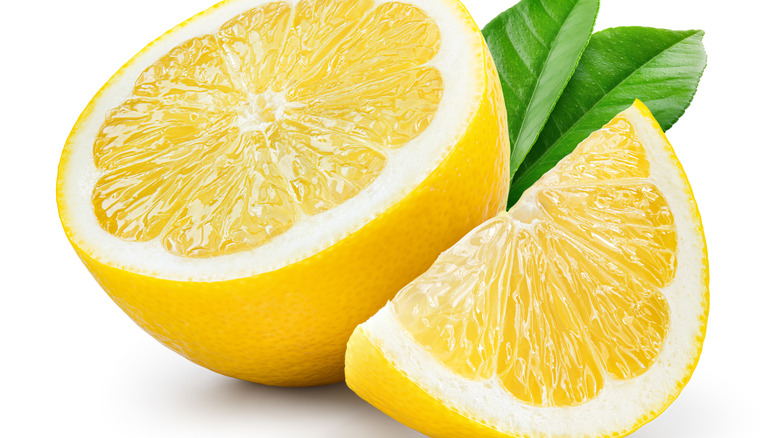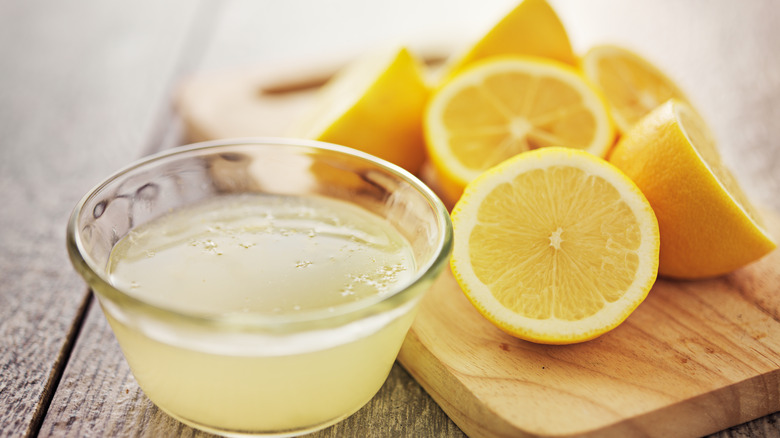The Simple Technique To Squeeze Lemons Without Dropping Seeds
Many dishes are sharpened by the acidic tang of citrus and, perhaps, no fruit is more versatile than the good ol' lemon. Sunny yellow, and cheery, with a bright sourness, lemons can enhance flavor, make gorgeous natural garnishes, and work their culinary magic in everything, from meringue to ceviche. Healthline also reminds us that lemons are high in vitamin C and citric acid, which helps the body extract iron from plant foods. So they're especially useful for people who are iron deficient or vegetarian. All the more reason to show lemons some love!
However, like avocados, cooking with lemons does take a little extra effort on the cook's part. To start with, you need to look for round, good-sized lemons with a slight give and thinner peels — they have the most juice, according to America's Test Kitchen. If you're zesting a lemon or candying its peel, it might be best to go organic, per Foodprint. But the real challenge is preventing the lemon seeds from slipping right into your dish, even if you have a juicing tool. And it's just annoying to hunt around for elusive seeds or chomp down on them while eating. Fortunately, Rachael Ray's got you covered with an easy hack for squeezing lemons without dropping the seeds.
The power of lemon in your hands
In a YouTube video, Rachael Ray demonstrates how you can simply hold your lemon half with the cut side up, firmly in your hand. When you squeeze the lemon, the juice gets into the dish, and the seeds are held in place. No more squirting slippery seeds into your food, or juice spraying everywhere except where it needs to go. Men's Health explains that you don't need to crush the lemon with all your might; just gently press the lemon (away from your eyes!) until the juice begins to flow down toward the lemon's convenient tapered end. If you haven't picked the seeds out with a fork beforehand, jettison them as they appear, Men's Health adds.
Rachael Ray also says (via News 4 San Antonio) to microwave lemons (and other citrus) on high for 20 to 30 seconds to help them relinquish their juice. Per Oprah, this method equates to an hourlong sit at room temperature, helping the membranes in the lemon soften for easy squeezing. This is important because you might not get as much juice from a lemon if you juice them cut side up. Good Housekeeping says to keep the lemon intact for its quick zap and to let it cool before you grab it.
Other uses for lemon
Alternatively, you can wash your lemon and soak it in warm water to further alleviate the juicing process, or roll it (whole) on a hard surface. If you're fortunate enough to own a lemon presser/squeezer, follow Martha Stewart's advice and cut the ends off the fruit to seat it properly in the presser and extract more of that wonderful juice. Or, go the TikTok route and poke a hole in the lemon, like the straw in those old Tropicana OJ commercials. Admit it: you always wanted to see if that would work.
Now that lemons have been rendered more user-friendly, you no longer need to dread using them. Try your (lemon-scented) hand at classic lemon curd, or get a healthy boost from lemon water. Then there are always Rachael Ray recipes like lemon spaghetti, garlic roast chicken with rosemary and lemon, lemon ricotta cookies, or limoncello parfaits. When life gives you lemons, you can make much more than lemonade.


